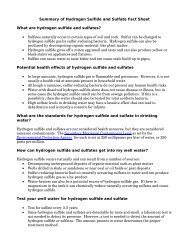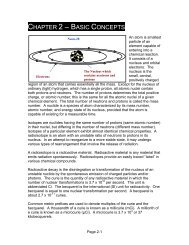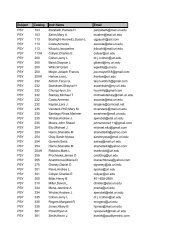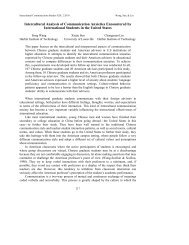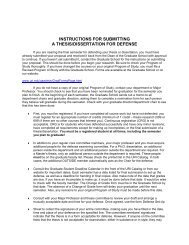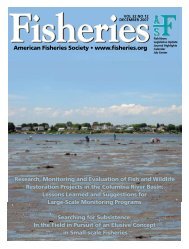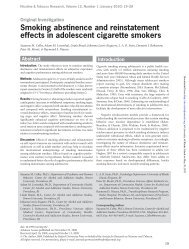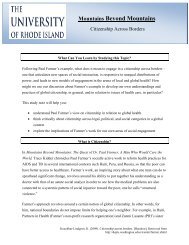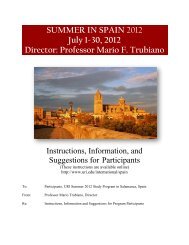- Page 1 and 2: Appendix A Standard Operating Proce
- Page 3 and 4: 4. Report ANY accidents IMMEDIATELY
- Page 5 and 6: SUBJECT: Hazardous Materials and Ch
- Page 7 and 8: 2.0 METHOD USED TO OBTAIN ULTRAPURE
- Page 9 and 10: Standard Operating Procedure 003 Ge
- Page 11 and 12: 3.2.2 Full Description of Labware C
- Page 13 and 14: Standard Operating Procedure 004 Ge
- Page 15 and 16: 4. Open the door and remove the loa
- Page 17 and 18: Standard Operating Procedure 005 Bo
- Page 19 and 20: 3 of 3 Autoclave Use / Maintenance
- Page 21 and 22: 7. Close the door, and lock it by t
- Page 23 and 24: Standard Operating Procedure 007 (P
- Page 25 and 26: Several chemicals are utilized in t
- Page 27 and 28: Required Material Notes Re-order in
- Page 29 and 30: 5.2 Quality Assurance/Quality Contr
- Page 31 and 32: mixed it will be filtered and treat
- Page 33 and 34: Procedure All equipment to come int
- Page 35 and 36: 5. After completion of the autoclav
- Page 37 and 38: 5. Label at least one plate from ea
- Page 39: 18. After 2 hours in the incubator
- Page 43 and 44: Dil. (mLs): The volume of sample fi
- Page 45 and 46: Bacterial Sample Log & Worksheet: B
- Page 47 and 48: Standard Operating Procedure 008 (P
- Page 49 and 50: handling these chemicals. Material
- Page 51 and 52: Required Material 4 of 22 Notes Re-
- Page 53 and 54: 5.2 Quality Assurance/Quality Contr
- Page 55 and 56: 5.2.8 QA Check on New Plates E. col
- Page 57 and 58: 7. While the mTEC media is autoclav
- Page 59 and 60: 12 of 22 5.3.2.3 Preparation of 1N
- Page 61 and 62: 4. Label the bottom (half holding t
- Page 63 and 64: 20. Transfer the plates to the 44.5
- Page 65 and 66: 8.0 DOCUMENTATION Example Project D
- Page 67 and 68: URI Watershed Watch Laboratory Quar
- Page 69 and 70: Date 22 of 22 URI Watershed Watch L
- Page 71 and 72: Standard Operating Procedure 009 (P
- Page 73 and 74: Disposal Samples are archived for a
- Page 75 and 76: 3. Aluminum weigh dishes, pans, and
- Page 77 and 78: a. If a sample clogs a filter, remo
- Page 79 and 80: 8.0 DOCUMENTATION Example Data Shee
- Page 81 and 82: Standard Operating Procedure 010 (P
- Page 83 and 84: 4.2 pH and Alkalinity Matrix Sample
- Page 85 and 86: are stored in bulk in the cabinet a
- Page 87 and 88: 5.3.3 Procedure - Analysis of pH on
- Page 89 and 90: 5. Use a non-acid washed graduated
- Page 91 and 92:
8.0 DOCUMENTATION Data sheet for an
- Page 93 and 94:
Standard Operating Procedure 011 (P
- Page 95 and 96:
3.0 REQUIRED MATERIALS Required Mat
- Page 97 and 98:
field blank water and 100 mL of the
- Page 99 and 100:
procedure. The DO probe should not
- Page 101 and 102:
5.3.2 Procedure - Day of Sample Col
- Page 103 and 104:
13. The water seal of the BOD bottl
- Page 105 and 106:
7.0 REFERENCES 100 - 350 350 - 500
- Page 107 and 108:
14 of 14 BI - 12 Fla STE -S 5 BI -
- Page 109 and 110:
Standard Operating Procedure 012 (P
- Page 111 and 112:
Required Material Notes Re-order in
- Page 113 and 114:
Filter Blank Filter blanks consist
- Page 115 and 116:
8. When the fluorometer calls for t
- Page 117 and 118:
5.2.5 Calibration Check/Laboratory
- Page 119 and 120:
6. Check the calibration of the rep
- Page 121 and 122:
5.3.2.2 Preparation of 100 mL of 1N
- Page 123 and 124:
5.3.3.1 Procedure for Diluting Off-
- Page 125 and 126:
7.0 REFERENCES APHA, AWWA, WEF. Sta
- Page 127 and 128:
Chlorophyll-a Calibration Record Ca
- Page 129 and 130:
Chlorophyll-a Analysis Data Sheet N
- Page 131 and 132:
Standard Operating Procedure 013 (P
- Page 133 and 134:
Required Material Notes Re-order in
- Page 135 and 136:
samples are analyzed until an accep
- Page 137 and 138:
5.3.1.1 Preparation of 1000 ppm NaC
- Page 139 and 140:
2. Prepare a filter housing by plac
- Page 141 and 142:
2. Pipette 100 µl of the chloride
- Page 143 and 144:
7.0 REFERENCES APHA, AWWA, WEF. Sta
- Page 145 and 146:
Standard Operating Procedure 014 (P
- Page 147 and 148:
parts and eyes. Sulfuric Acid (H2SO
- Page 149 and 150:
The available volume of each reagen
- Page 151 and 152:
Corrective Action If the %D is grea
- Page 153 and 154:
. Values returned by the balance sh
- Page 155 and 156:
5. Shake the unfiltered sample bott
- Page 157 and 158:
5.3.2.3 Sample Analysis Detailed in
- Page 159 and 160:
7.0 REFERENCES APHA, AWWA, WEF. Sta
- Page 161 and 162:
Standard Operating Procedure 015 (P
- Page 163 and 164:
2.0 HEALTH AND SAFETY CONSIDERATION
- Page 165 and 166:
Required Material Notes Re-order in
- Page 167 and 168:
6 of 19 5.2.1 Method Detection Limi
- Page 169 and 170:
and the samples analyzed between th
- Page 171 and 172:
10 of 19 serviced and re-calibrated
- Page 173 and 174:
X 20 400 X 25 500 X 50 1000 (1.0 mL
- Page 175 and 176:
they must be placed in the freezer
- Page 177 and 178:
Th ese instruction allow for the cr
- Page 179 and 180:
6. After the computer results are p
- Page 181 and 182:
USample Log Sheet SR1 SYNC (High st
- Page 183 and 184:
1 of 25 Standard Operating Procedur
- Page 185 and 186:
Required Material Notes Re-order in
- Page 187 and 188:
Required Material Notes Re-order in
- Page 189 and 190:
Corrective Action If any method (di
- Page 191 and 192:
Corrective Action If the %D is grea
- Page 193 and 194:
The percent recovery is calculated
- Page 195 and 196:
All phosphorus glassware should be
- Page 197 and 198:
adjustable pipette to add intermedi
- Page 199 and 200:
Preparation of Nitrate/Nitrite Work
- Page 201 and 202:
c. Enter SPK2 for the spike number
- Page 203 and 204:
Digesting Reagent for Total Phospho
- Page 205 and 206:
. The standard curve is rejected if
- Page 207 and 208:
Sample Log Sheet SR1 SYNC (High std
- Page 209 and 210:
Standard Operating Procedure 017 Sa
- Page 211 and 212:
5.2.3 Sample Replication Sample rep
- Page 213 and 214:
Sample Data Sheet Analysis Tech's R
- Page 215 and 216:
Salinity Analysis SOP 017 S:\WW\aww
- Page 217 and 218:
Standard Operating Procedure 018 En
- Page 219 and 220:
4.0 SAMPLE STORAGE, PRESERVATION AN
- Page 221 and 222:
eanalyzed. The field samples will b
- Page 223 and 224:
c. Dilute to the 100 mL mark on the
- Page 225 and 226:
7.0 CALCULATIONS Record the number
- Page 227 and 228:
11 of 21 Enterolert SOP 018 filenam
- Page 229 and 230:
8.0 REFERENCES APHA, AWWA, WEF. Sta
- Page 231 and 232:
Sample Bottle Sterility Check Bacte
- Page 233 and 234:
URI Watershed Watch Laboratory Quar
- Page 235 and 236:
19 of 21 Enterolert SOP 018 filenam
- Page 237 and 238:
21 of 21 Enterolert SOP 018 filenam
- Page 239 and 240:
Figure 1: Balance Calibration Data
- Page 241 and 242:
Required Material Notes Re-order in
- Page 243:
6.0 DOCUMENTATION 4 of 5 Bacterial



